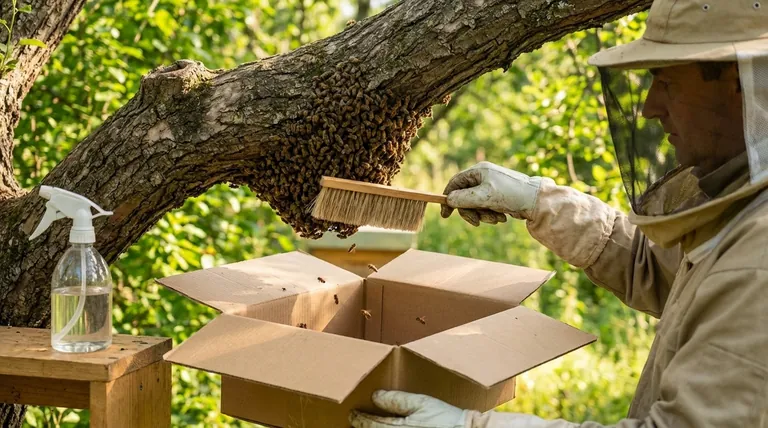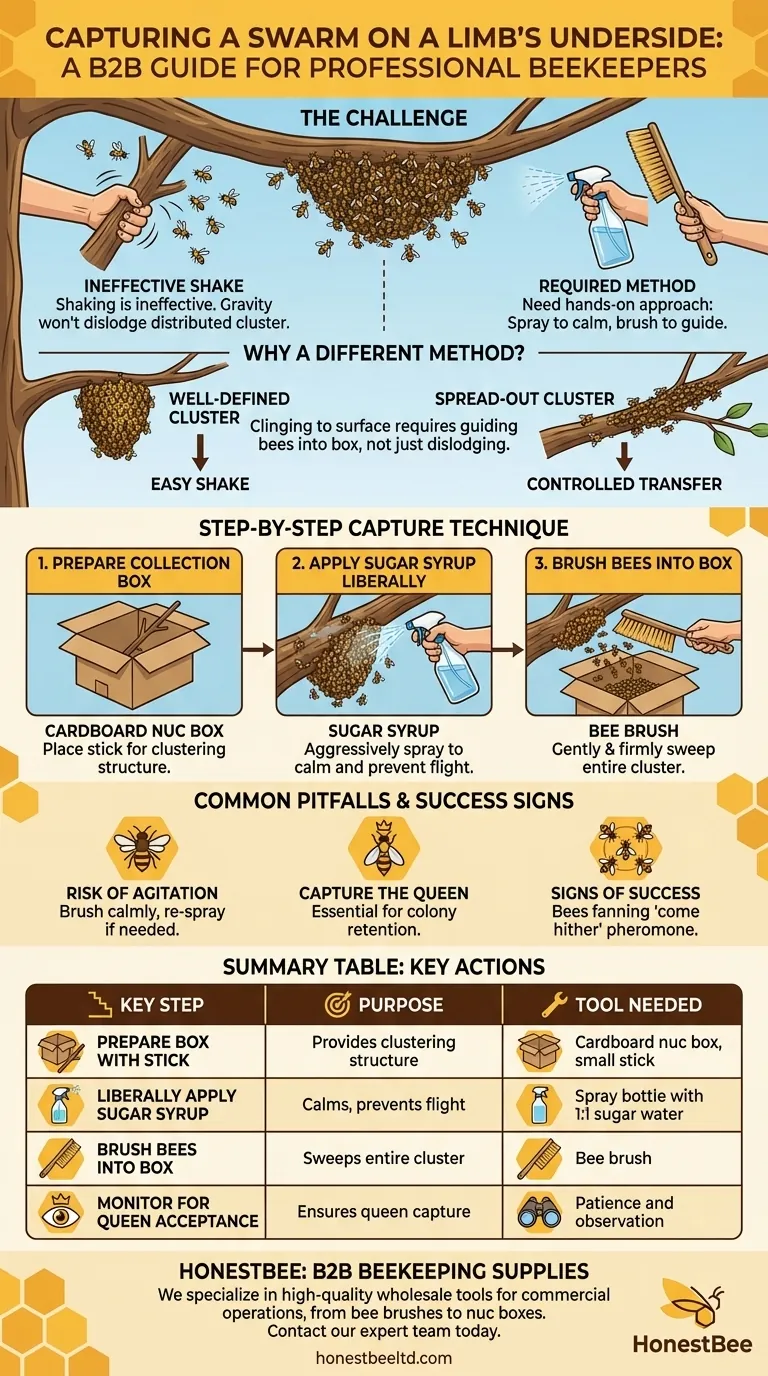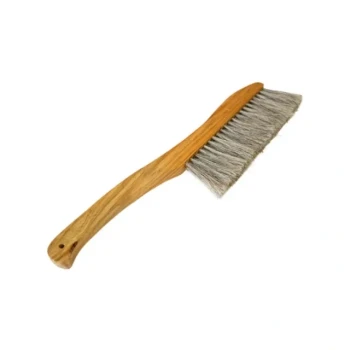When a bee swarm clings to the underside of a tree limb, a simple shake is ineffective. Your approach must shift from dislodging the cluster to methodically sweeping the bees into a collection box after thoroughly spraying them with sugar syrup. This technique requires more direct contact but is essential for capturing a swarm that is spread out and firmly attached.
The core challenge with a swarm on the bottom of a limb is their grip and distribution. You cannot rely on gravity alone. Success depends on using sugar water to prevent flight and a bee brush to gently but firmly persuade the entire cluster into your prepared container.

Why This Situation Demands a Different Method
A swarm hanging from a branch in a well-defined cluster is often easy to capture. One firm shake, and the majority of the bees, including the queen, fall directly into a box. A swarm spread along the underside of a limb is an entirely different scenario.
The Ineffectiveness of Shaking
Bees clinging to a flat or curved surface have a much stronger and more distributed hold than a hanging cluster. Attempting to shake the limb will dislodge only a fraction of the bees, scattering them and potentially making them more defensive.
The Goal: A Controlled Transfer
Your objective is not just to get the bees off the branch, but to convince them to re-cluster inside your collection box. This requires a more hands-on approach that guides them into their new, temporary home.
The Step-by-Step Capture Technique
Precision and preparation are key to ensuring the bees move from the limb to your box with minimal stress and disruption.
Step 1: Prepare the Collection Box
Before approaching the bees, prepare your container (a cardboard nuc box or similar). Place a small stick or twig diagonally inside.
This stick is crucial. It gives the bees an immediate structure to hold onto and begin clustering once they are inside the box, making them feel more secure and simplifying their eventual transfer into a proper hive.
Step 2: Apply Sugar Syrup Liberally
Using a spray bottle, coat the entire swarm with a 1:1 sugar water solution. Be more aggressive with the spray than you would for a hanging cluster.
The syrup serves two purposes: it calms the bees by inducing their grooming instinct, and it makes their wings sticky and heavy, significantly reducing their ability to fly away.
Step 3: Brush the Bees into the Box
Hold your open collection box directly beneath the swarm. With a bee brush, use gentle but firm downward strokes to sweep the bees off the limb and into the box.
Work methodically from one end of the cluster to the other. Patience is critical; you will likely need to make several passes to encourage all the bees to let go.
Common Pitfalls to Avoid
While effective, this method is more invasive than a simple shake and carries its own set of risks that you must manage.
Risk of Agitation
Directly brushing bees is more disruptive than shaking them. Work calmly and deliberately. If the bees become overly agitated and airborne, step back for a few minutes and reapply sugar syrup before continuing.
Failing to Capture the Queen
The entire effort hinges on getting the queen into the box. If she remains on the limb, the bees you have brushed into the box will quickly abandon it and return to her.
Giving Up Too Soon
This process can take time. If bees begin to return to the branch, it means the queen is likely still there. You may need to repeat the brushing process on the remaining cluster until you see signs that the capture was successful. The most important sign is seeing bees at the entrance of the box fanning their wings to release the "come hither" pheromone, which tells the rest of the swarm that the queen is inside.
Making the Right Choice for Your Goal
Your actions should be dictated by the behavior of the bees and your primary objective of safely capturing the entire colony.
- If your primary focus is a calm, controlled capture: Be generous with the sugar syrup and use slow, methodical brush strokes. Prioritize gentleness over speed to keep the colony calm.
- If your primary focus is ensuring you have the queen: Pay close attention to the bees' behavior after your first few sweeps. If they are not beginning to march into the box and are instead flying back to the limb, refocus your efforts on the area where the cluster was densest.
By trading the jarring shake for a methodical sweep, you can safely and effectively capture even the most stubbornly placed swarms.
Summary Table:
| Key Step | Purpose | Tool Needed |
|---|---|---|
| Prepare Box with Stick | Provides structure for bees to cluster inside | Cardboard nuc box, small stick |
| Liberally Apply Sugar Syrup | Calms bees and prevents flight by weighing wings | Spray bottle with 1:1 sugar water |
| Brush Bees into Box | Gently sweeps the entire cluster from the limb | Bee brush |
| Monitor for Queen Acceptance | Ensures the queen is captured; the colony will stay | Patience and observation |
Need reliable beekeeping supplies for swarm capture and hive management? As HONESTBEE, we specialize in supplying commercial apiaries and beekeeping equipment distributors with the high-quality, wholesale tools required for professional beekeeping operations. From durable bee brushes to efficient nuc boxes, our equipment is designed for success in the field.
Contact our expert team today to discuss your supply needs and discover how we can support your business's growth.
Visual Guide

Related Products
- Wooden Bee Brush with Double-Row Horsehair Bristles
- Classic Wooden Bee Brush with Double-Row Boar Bristles
- Wooden Bee Brush with Triple Row Artificial Fiber for Beekeeping
- Plastic Handle Single Row Artificial Fiber Bee Brush
- Premium Triple-Row Horsehair Bee Brush
People Also Ask
- What are some optional tools that can be useful in beekeeping? Boost Efficiency & Hive Health
- What are the characteristics of the bristles on a bee brush? Designed for Gentle Persuasion, Not Force
- What is a bee brush and how is it used in beekeeping? A Guide to Gentle Bee Handling
- What is the primary use of a bee brush during inspections and extraction? Essential for Gentle Bee Handling
- What is a bee brush used for? Gently Sweep Bees from Honeycomb Frames



















